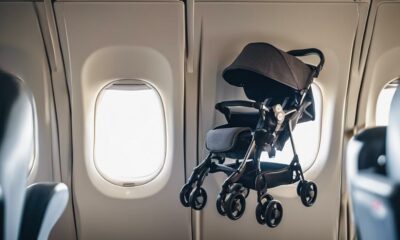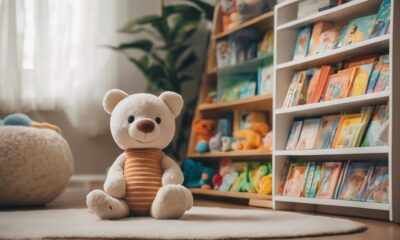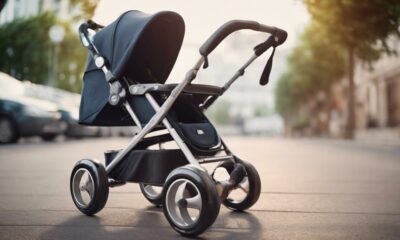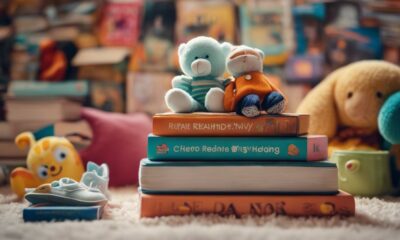Activities and Learning
Bye-Bye Baby: Understanding Separation Anxiety
Anxiously navigating separation anxiety in babies and toddlers? Discover causes, signs, coping strategies, and interventions to support your little one's emotional well-being.

Understanding separation anxiety in babies and toddlers is crucial. Causes can include developmental milestones and major life changes. Signs like clinginess, fear of strangers, and crying upon separation are common. Coping strategies involve routines, short separations, and seeking guidance. Separation anxiety impacts family dynamics and attachment bonds greatly. Professional interventions, such as counseling and creating supportive environments, can provide help. Effective coping methods include consistent routines and seeking professional assistance for long-term solutions. By comprehending these aspects, you secure the well-being and healthy development of your little ones.
Key Takeaways
- Developmental milestones trigger separation anxiety in babies and toddlers.
- Object permanence contributes to feelings of insecurity during separations.
- Secure attachment can help mitigate separation anxiety in children.
- Coping strategies include routines, short separations, and seeking guidance.
- Separation anxiety impacts family dynamics, attachment bonds, and relationships.
Causes of Separation Anxiety
The causes of separation anxiety in children can be attributed to various factors, including developmental milestones and major life changes. During childhood development, milestones like object permanence play a significant role in triggering separation anxiety. As children start to understand that objects and people exist even when they're out of sight, they may struggle with the absence of a caregiver, leading to feelings of insecurity and fear of separation.
Additionally, major life changes such as the arrival of a new sibling can disrupt a child's sense of security and attachment, intensifying separation anxiety.
Secure attachment plays an important role in mitigating separation anxiety. When children have a strong bond with their caregivers, they feel more confident and secure when faced with temporary separations. On the contrary, parenting styles that discourage independence may exacerbate clinginess and separation anxiety in children, hindering their ability to cope with separations effectively.
Signs in Babies and Toddlers
Understanding the signs of separation anxiety in babies and toddlers is essential for caregivers to provide support and reassurance during challenging moments of increased clinginess and fear of separation. Here are key signs to look out for:
- Increased Clinginess: Babies and toddlers may become more attached and clingy to their primary caregiver, seeking constant reassurance and proximity.
- Fear of Strangers: Infants might exhibit fear or discomfort around unfamiliar faces, preferring familiar individuals.
- Crying when Caregiver Leaves: Babies may cry or become upset when separated from their caregiver, fearing abandonment.
- Fear of Caregiver Not Returning: This fear stems from object permanence development, where babies start understanding that objects (or people) continue to exist even when out of sight, causing distress when separated from their caregiver.
These signs often peak around 9 months of age, but can also resurface during toddlerhood. It's essential for caregivers to be patient and understanding during these phases of heightened separation anxiety.
Coping Strategies for Families

To effectively manage separation anxiety within your family, consider implementing practical coping strategies that promote a sense of security and comfort for your child.
Importance in routines and rituals plays a significant role in easing separation anxiety. Establishing a predictable schedule can help your child feel more secure and prepared for separations.
Providing attention and affection during separations is important; reassuring your child that you'll return builds trust and confidence. Keeping promises of your return time reinforces this trust.
It's also beneficial to practice short separations to help your child get used to being apart from you.
Seeking guidance from a pediatrician or counselor can provide effective coping strategies tailored to your family's needs. Consulting a professional can offer valuable insights and support in managing separation anxiety.
Impact on Family Dynamics
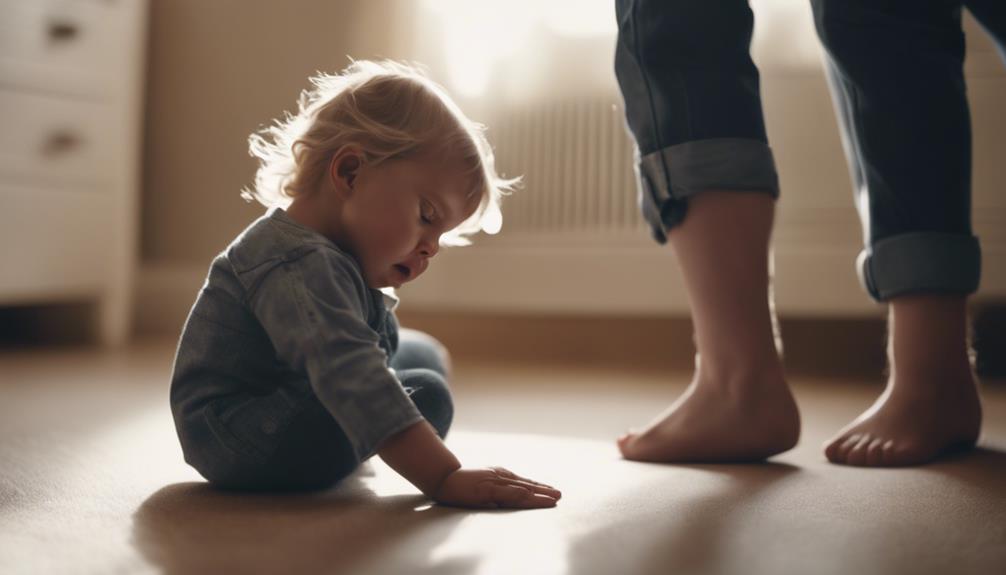
Consider how separation anxiety impacts the dynamics within your family, affecting both caregivers and children in various ways.
Caregivers may experience distress when witnessing their child's anxiety, feeling overwhelmed by the situation.
Children, on the other hand, might exhibit clinginess, tantrums, or trouble sleeping due to their separation anxiety.
Family Dynamics: Separation anxiety can disrupt the usual routines and interactions within the family, requiring adjustments to accommodate the child's needs.
Caregivers Support: Providing support and reassurance to caregivers is essential in helping them manage their own distress while guiding the child through their anxiety.
Impact on Children: Children may struggle with separation anxiety, leading to difficulties in social settings or during changes.
Guidance for Managing: Seeking guidance from healthcare professionals can assist in developing strategies to address separation anxiety effectively, benefiting both caregivers and children in the long run.
Professional Interventions for Support

Seeking professional interventions for support is essential in effectively addressing separation anxiety disorder in both caregivers and children. Family counseling and school cooperation play an important role in providing thorough assistance. Through family counseling, all members can gain a better understanding of the disorder and learn how to support each other during challenging times.
School collaboration is also crucial in creating a supportive environment for the child. Individual counseling for the child can help them develop coping strategies and manage their anxiety more effectively.
Moreover, establishing a less stressful environment at home and school can greatly benefit children dealing with separation anxiety. Educating family members about the disorder is key to fostering patience and empathy. By taking these steps and seeking professional guidance, caregivers can better support their children and help them navigate through the challenges of separation anxiety disorder.
If you're in need of assistance, consider contacting (801) 215-9581 for a free consultation to obtain expert advice on managing your child's anxiety.
Understanding Children's Emotions
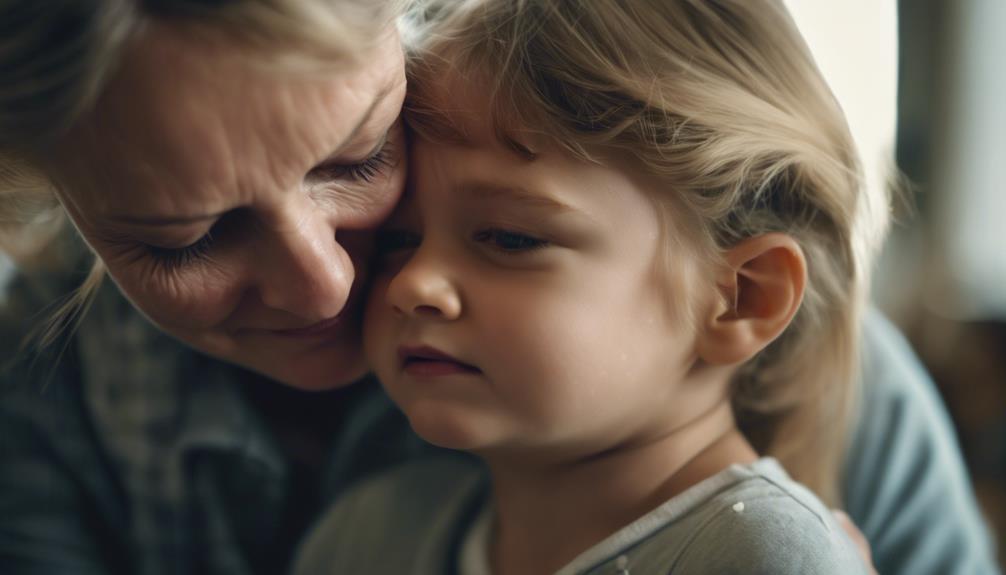
Children's emotions play a significant role in the development of separation anxiety. Understanding how emotions evolve in children can help you navigate this challenging phase with empathy and patience.
Children's Emotional Development
Understanding children's emotions is vital for their overall emotional development and well-being. Children, from babies to older kids, go through various stages in their emotional development.
Here are some key points to keep in mind:
- Children's emotional development includes learning to identify, express, and regulate their emotions.
- Understanding emotions helps children build social skills and develop empathy.
- Emotional development in children is influenced by genetics, environment, and experiences.
- Children's emotional development progresses through stages, from basic emotions to more complex feelings.
As a caregiver or family member, it's essential to support children as they navigate their emotional development. This support lays the foundation for healthy relationships and helps children develop independence.
Managing Separation Anxiety
Managing separation anxiety involves creating a supportive environment to help children navigate their emotions effectively. Consistency in routines is key to helping children feel secure and confident during changes.
One effective strategy is to establish a good-bye ritual. This ritual can be as simple as a special wave or saying a specific phrase before leaving. According to child development experts, 'Having a routine can provide a sense of predictability for children, which can help reduce separation anxiety.'
In addition to routines, providing reassurance and comfort can also help ease separation anxiety. Acknowledging your child's feelings and offering support is crucial. Remember, separation anxiety is a normal part of infant development, and with the right approach, children can learn to manage it.
Long-Term Effects and Solutions
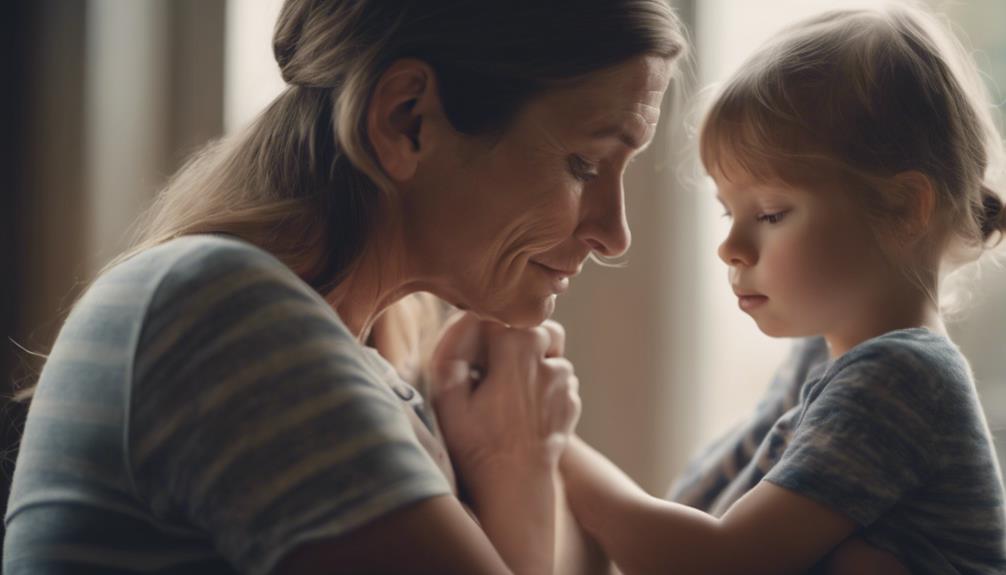
When examining the long-term effects of separation anxiety, it's important to take into account how it impacts attachment bonds and relationships over time. Effective coping strategies, such as consistent routines and seeking professional help when needed, can play a significant role in mitigating these effects.
Understanding the significance of early intervention and providing the necessary support can help prevent lasting emotional consequences for the child.
Effects on Attachment Bonds
Long-term effects of separation anxiety can impair the formation of secure attachment bonds, impacting trust and relationships in adulthood. Children experiencing unresolved separation anxiety may face challenges in developing secure attachment bonds, leading to difficulties in trusting others and forming healthy relationships later in life.
- Individuals with unresolved separation anxiety may struggle to establish secure attachment bonds, affecting their ability to trust others.
- The impact of separation anxiety on attachment bonds can extend into adulthood, influencing the quality of relationships.
- Early intervention is vital in addressing separation anxiety and preventing long-term effects on attachment bonds.
- Building a secure attachment bond through consistent care and supportive interventions can help alleviate the effects of separation anxiety on attachment bonds.
Understanding the significance of attachment bonds and the repercussions of separation anxiety on trust and relationships underscores the importance of early intervention and targeted strategies to promote healthy development.
Effective Coping Strategies
To effectively address the long-term effects of separation anxiety and find lasting solutions, it is important to focus on implementing effective coping strategies early on. Developing healthy coping mechanisms takes time and effort but can greatly help ease separation anxiety in young children. One effective strategy is to provide a special blanket or toy that the child associates with comfort and security. According to child psychologist Dr. Smith, 'Having a transitional object can act as a source of comfort when the child is separated from their caregiver.' Additionally, creating a consistent farewell routine can help the child feel more secure and understand that separation is a normal part of life. Dr. Johnson emphasizes, 'Consistency and predictability can play a significant role in helping children cope with separation anxiety.' By proactively addressing separation anxiety through these strategies, you can support your child in developing resilience and overcoming robust separation anxiety in the long term.
| Coping Strategies | Benefits |
|---|---|
| Special blanket or toy | Comfort and security |
| Consistent farewell routine | Sense of normalcy and predictability |
| Seeking professional help | Effective long-term solutions |
| Supportive environment | Overcoming separation anxiety with resilience |
| Healthy coping mechanisms | Adapting well to future challenges |
Frequently Asked Questions
At What Age Do Babies Get Separation Anxiety?
Babies typically develop separation anxiety around 9 months of age. Signs may start as early as 4-5 months due to object permanence. By 9 months, most infants experience separation anxiety, indicating a normal developmental milestone and secure attachment.
At What Age Does Separation Anxiety Typically Peak?
Separation anxiety typically peaks in babies between 8-10 months and again in toddlers around 14-18 months. During this time, you might notice increased clinginess and crying as your little one forms strong attachments to you.
How Do You Respond to a Baby With Separation Anxiety?
When your baby's anxious, hold them close, whispering soft reassurances. Slowly introduce short separations and maintain reliable routines. Offer a special toy or blanket for comfort. If worries linger, seek advice from a pediatrician for support and guidance.
How to Help a Baby With Separation Anxiety Sleep?
To help a baby with separation anxiety sleep, establish a consistent bedtime routine, offer a security object, stay calm during changes, avoid sneaking out, comfort them if they wake up, and leave calmly to encourage self-soothing.
Conclusion
In summary, understanding separation anxiety in babies and toddlers is essential for families to effectively cope with this common developmental stage. By recognizing the signs, implementing coping strategies, seeking professional support when necessary, and prioritizing children's emotional well-being, families can navigate this challenging time with patience and empathy.
Remember, like a bird learning to fly, your little one will eventually spread their wings and soar, leaving separation anxiety behind as they grow and thrive.
Activities and Learning
Chill Out With Fun Winter Activities
Tantalize your winter with a mix of traditional and thrilling activities that will make the season unforgettable.

Winter offers a plethora of enjoyable activities to unwind and have fun. You can lace up and glide across the ice at skating rinks in a festive atmosphere. Indulge in comforting homemade hot chocolate treats that warm both body and soul. Engage with nature by feeding birds in your backyard with a variety of seeds. Immerse yourself in classic games like noughts and crosses to foster creativity and competition. Get out in the snow for adventures like building snow forts, sledding down hills, or creating snow sculptures. These activities are just the beginning of a truly wonderful winter experience.
Key Takeaways
- Ice skating offers exhilarating fun for all ages in a festive atmosphere.
- Enjoy comforting hot chocolate treats, perfect for warming up during winter.
- Delight in bird feeding to connect with nature and bring joy.
- Engage in classic paper and pencil games for nostalgic entertainment.
- Embark on snow day adventures like snowball fights and sledding for outdoor excitement.
Ice Skating Fun
Ice skating, a delightful winter activity enjoyed by individuals of all ages, brings joy and laughter to those gliding across the ice.
Skating rinks, a common sight during the winter season, cater to both beginners and experienced skaters, offering a festive atmosphere filled with excitement.
Laughter, screams, and occasional falls are all part of the ice skating experience, making it a thrilling adventure for children and adults alike.
The sound of blades slicing through the ice and the cool breeze on your face create a sense of freedom and exhilaration.
Whether twirling gracefully or simply trying to stay upright, ice skating provides a wonderful way to embrace the winter season and create lasting memories with loved ones.
Hot Chocolate Treats

During the winter season, indulging in hot chocolate treats can be a comforting and delightful experience. Homemade hot chocolate is a simple yet satisfying treat that warms both body and soul.
By combining chopped chocolate with hot milk, you can create a rich and indulgent beverage perfect for sipping after outdoor activities in cold weather. This beverage can be a great way to involve children in the kitchen, allowing them to assist in the preparation of this cozy drink.
For those looking to elevate their hot chocolate experience, there are various deluxe versions of recipes to explore, from peppermint-infused to caramel-drizzled creations.
Whether enjoyed alone or with loved ones, hot chocolate treats are sure to bring warmth and joy during the chilly winter months.
Bird Feeding Delight

Homemade hot chocolate treats offer a cozy winter indulgence, and another delightful winter activity worth exploring is bird feeding. Feeding the birds during the winter months can bring joy and a sense of connection to nature.
Here are some tips to make bird feeding a delightful experience:
- Choose a variety of bird seeds to attract different bird species.
- Place bird feeders in safe and accessible locations for easy refilling.
- Keep bird feeders clean to prevent the spread of diseases among birds.
- Consider adding suet cakes or nuts for high-energy treats that birds love.
Classic Game Time

Engaging in traditional games offers a nostalgic and interactive pastime during the winter season. Paper and pencil games like noughts and crosses, hangman, and battleships provide a fun alternative to screen time. These classic games are not only entertaining but also encourage creativity and strategic thinking.
Adding a competitive element by offering prizes like sweets can make the experience even more exciting for participants. Playing old school games can create a lively atmosphere filled with laughter, shouting, and giggling.
Choosing paper and pencil games as a winter activity allows children and adults alike to enjoy guilt-free entertainment without the need for electronic devices, fostering a sense of togetherness and camaraderie.
Snow Day Adventures

Snow days present a perfect opportunity to embrace outdoor winter activities and create lasting memories with loved ones. Here are four exciting snow day adventures to enjoy:
- Building snow forts and having epic snowball fights
- Sledding down hills and feeling the rush of the cold wind
- Creating intricate snow sculptures like snowmen or animals
- Going on a winter hike to explore the snowy landscapes
These activities not only provide fun and excitement but also promote bonding and appreciation for the winter season. Make the most of snow days by engaging in these adventurous and memorable experiences with family and friends.
Frequently Asked Questions
Can I Bring My Own Ice Skates to the Skating Rink?
Yes, you can bring your own ice skates to the skating rink. Many facilities allow visitors to bring their own skates. It is always recommended to check the rink's policies beforehand to confirm that personal skates are permitted for use.
What Type of Chocolate Works Best for Homemade Hot Chocolate?
For homemade hot chocolate, using high-quality chocolate with a cocoa content of around 70% works best. This type of chocolate provides a rich and decadent flavor that enhances the overall taste of the hot chocolate, creating a delightful treat for cold winter days.
Is There a Specific Time of Day to Feed Birds in Winter?
Feeding birds in winter can be done at any time of day. However, mornings are ideal as birds are actively foraging for food. Regular feeding can help support wildlife during the scarcity of winter, providing a rewarding experience for both birds and observers.
Are There Age Restrictions for Playing Old School Games?
There are typically no age restrictions for playing old school games. These games, like noughts and crosses or hangman, are enjoyable for all ages. They provide screen-free entertainment and can be a fun and engaging activity for children and adults alike.
What Should I Wear for Snowball Fights and Sledding?
Dress for snowball fights and sledding as if preparing for a battle with winter's icy foes. Opt for waterproof, insulated layers, sturdy boots, gloves, and a hat. Embrace the chill like a snow warrior, ready for snowy adventures.
Conclusion
To wrap up, winter activities offer a delightful way to embrace the season's charm and create lasting memories.
Did you know that ice skating burns approximately 250-400 calories per hour, making it a fun and calorie-burning activity?
Enjoy the winter wonderland while staying active and indulging in cozy treats.
Activities and Learning
Enter Now to Win Amazing Book Bundle
Wander into a world of literary treasures by entering to win an amazing book bundle – the perfect addition to your collection!

Discover how to win an enticing book bundle including titles like 'A Dad Joke A Day' and 'You're Going To Be A Dad!'. Participants aged 18 and above across the globe are eligible. To enter, engage with official social media accounts, like and share the post, tag a friend, and follow specified guidelines for a higher chance of winning. Mark your calendars for the entry deadline, where a winner will be randomly selected and notified through provided contact details. Assure accuracy in information for a smooth prize claim process. Don't miss out on the details and steps to grab this exciting book bundle opportunity!
Key Takeaways
- Follow official social media accounts to enter.
- Like, share the giveaway post, and tag a friend.
- Entry deadline specified for participation.
- Winner selected randomly using reputable tool.
- Winner notified and announced on designated platform.
Prize Details and Eligibility
Discussing the prize details and eligibility for the amazing book bundle giveaway is essential for participants seeking to understand the reward and qualifications required to enter the contest.
The book bundle includes titles such as 'A Dad Joke A Day', 'You're Going To Be A Dad!', 'A Positive Birth', 'A Knock Knock Joke A Day', and 'The Tricky Riddles Book For Smart Kids'.
Participants must be 18 years or older to enter the giveaway. The contest is open internationally, allowing individuals from various regions to participate.
To be eligible, participants must follow the specific entry guidelines outlined in the giveaway announcement. Understanding the prize details and eligibility criteria is crucial for those interested in entering and potentially winning the exciting book bundle.
How to Enter the Giveaway

To participate in the giveaway for the amazing book bundle, interested individuals must adhere to the specified entry instructions provided in the contest announcement.
Here are three key steps to enter the giveaway successfully:
- Follow the official social media accounts associated with the giveaway.
- Like and share the giveaway post to increase your chances of winning.
- Tag a friend in the comments section of the giveaway post to spread the word.
Important Dates and Winner Selection

The selection of the giveaway winner and announcement of important dates will be carried out in line with the terms outlined in the contest rules. The deadline for entries is scheduled for [insert specific date and time].
Following the closure of the entry period, the winner will be randomly chosen using a reputable selection tool or method. Once the winner has been selected, they will be informed via the contact information provided during the entry process. It is vital for participants to verify that their contact details are accurate to prevent any issues with claiming their prize.
The announcement of the winner will be made on [insert platform where the announcement will be posted], providing transparency and making sure all participants are aware of the outcome.
Frequently Asked Questions
Can I Enter the Giveaway Multiple Times?
No, typically giveaways only allow one entry per person to guarantee fairness and equal opportunity for all participants. It is important to follow the rules and guidelines of the giveaway to maintain integrity.
Are the Books in the Bundle Suitable for All Ages?
The books in the bundle cater to different age groups, ranging from dad jokes for kids to guides for new dads and brain teasers for smart kids. The diverse content makes the bundle suitable for a wide audience.
Will the Books Be Available in Digital Format?
In the digital age, accessibility is key. While preserving the charm of physical books is crucial, offering digital formats can enhance reach and convenience. It is recommended to inquire about the availability of the book bundle in digital format.
How Will the Winner Be Notified?
The winner will be notified via email within 48 hours of the giveaway closing. Please make sure the email address provided during entry is accurate and regularly checked to avoid any delays in receiving notification.
Can I Transfer the Prize to Someone Else if I Win?
In adherence to the query about potential prize transferal, kindly be informed that prize transferability is subject to the specific terms and conditions governing the contest. It is advisable to review said conditions for accurate guidance.
Conclusion
Finally, seize the chance to win an exceptional book bundle and unlock the doors to a realm of literary marvels.
Broaden your perspectives, spark your creativity, and revel in a varied assortment of engaging stories and enlightening wisdom.
Enter now for an opportunity to enrich your intellect, nurture your spirit, and set off on a memorable voyage through the magic of books.
Do not overlook this opportunity to win and enhance your reading adventure to fresh levels.
Activities and Learning
Dads' Vital Role in Kids' Sports Success
Pondering how dads impact their kids' sports success? Discover the essential role fathers play in shaping young athletes' mental, physical, and social development.

Fathers play an essential role in children's sports success by positively impacting their mental, physical, and social development. Active involvement, encouragement, and positive support from dads can greatly enhance a child's sports experiences. Balancing competitiveness with constructive feedback is key in fostering a healthy sporting environment. Understanding that most young athletes won't turn professional and promoting skills beyond sports are vital aspects. Dads who instill a love for physical activity and teach life lessons through sports create a strong bond with their children. Their influence goes beyond the field, shaping well-rounded individuals.
Key Takeaways
- Fathers influence children's sports involvement significantly.
- Positive parenting and support enhance kids' sports experiences.
- Balancing competitiveness with encouragement is crucial.
- Realistic approach: not all young athletes turn professional.
- Teaching skills beyond sports strengthens parent-child bond.
The Importance of Dads in Sports
The pivotal role that fathers play in their children's sports involvement and development cannot be emphasized enough. Fathers who actively participate in their children's sports activities contribute significantly to their overall well-being.
Research shows that children engaged in team sports experience better mental health, physical fitness, and social skills development. Through sports, kids learn essential values like collaboration, cooperation, and teamwork, setting a strong foundation for their future.
Additionally, involvement in physical activities during childhood often translates into an active lifestyle in adulthood. Fathers who support and encourage their children in sports not only foster their athletic abilities but also instill valuable life lessons that extend far beyond the playing field.
Positive Parenting in Sports

Active involvement and positive support from parents play an important role in shaping children's experiences and success in sports. Studies indicate that kids enjoy sports more when their parents provide constructive and encouraging feedback.
Pushy behavior or criticism from parents can have a negative impact on a child's enjoyment of sports and may even deter them from participating. It is vital for parents, especially dads, to balance competitiveness with positive reinforcement to maintain a healthy and supportive environment for children in sports.
Realistic Approach to Sports
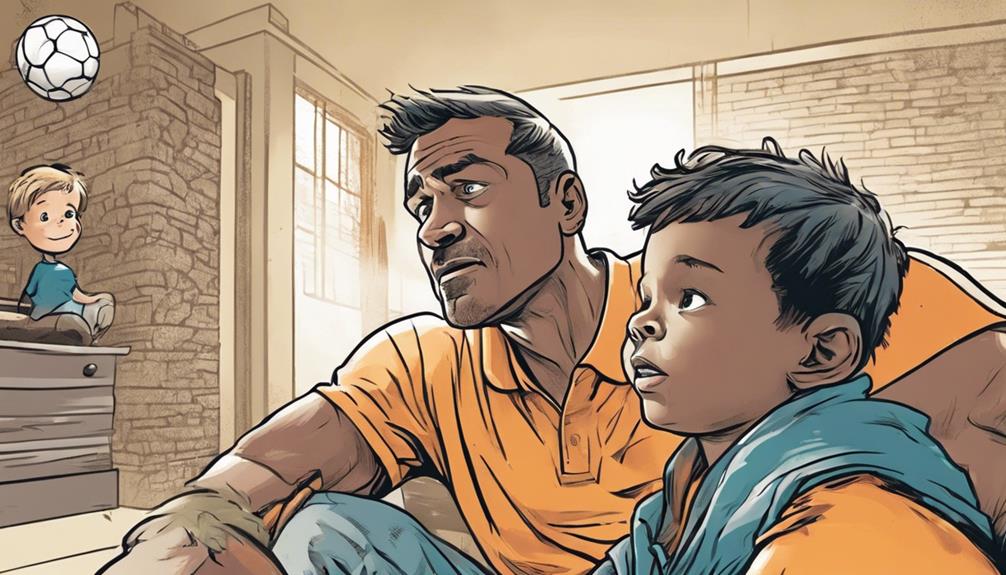
Parents, particularly fathers, should adopt a pragmatic perspective when guiding their children's involvement in sports. It is essential to maintain a realistic approach to sports, understanding that the vast majority of young athletes will not become professional players. Instead of solely focusing on dreams of fame and riches, dads can broaden their children's horizons by teaching skills beyond sports, such as cooking and coding. Encouraging an appreciation for physical activity and nature can instill lifelong healthy habits. A balanced approach to teaching sports not only benefits the child's development but also strengthens the parent-child bond.
| Benefits of a Realistic Approach to Sports | Impact |
|---|---|
| Fosters lifelong healthy habits | Positively influences long-term well-being |
| Strengthens parent-child bond | Builds a supportive and understanding relationship |
| Broadens children's skills beyond sports | Enhances overall personal development |
Frequently Asked Questions
Can Dads' Involvement in Kids' Sports Affect Their Academic Performance?
Dads' involvement in kids' sports can positively impact academic performance by promoting discipline, time management, and goal-setting skills. Active participation in sports fosters a well-rounded development that can translate into improved academic success and overall well-being.
How Can Dads Balance Their Own Sports Interests With Their Kids' Choices?
Dads can balance their sports interests with kids' choices by prioritizing children's preferences, fostering a supportive environment, and emphasizing enjoyment over competition. Engaging in shared physical activities can deepen the bond while promoting a healthy lifestyle.
What Are Some Creative Ways Dads Can Support Kids in Individual Sports?
Supporting kids in individual sports involves fostering independence while providing guidance. Dads can offer encouragement, attend competitions, help set goals, and celebrate achievements. Encouraging perseverance, resilience, and a positive attitude can help kids thrive in their chosen sport.
Are There Specific Sports That Dads Should Encourage Over Others?
Encouraging children to participate in sports offers numerous benefits such as improved mental health, physical fitness, social skills, and lifelong physical activity habits. Dads should prioritize sports that align with their child's interests and abilities for best development.
How Can Dads Handle Conflicts With Other Parents During Kids' Sports Events?
Dads facing conflicts with other parents during kids' sports events should prioritize calm, respectful communication. Focusing on the child's well-being and emphasizing sportsmanship over winning can help resolve disagreements and maintain a positive environment for all involved.
Conclusion
To sum up, fathers play a vital role in shaping young athletes' success and overall well-being in children's sports. Research shows that children with involved fathers are more likely to excel in sports and develop positive physical, mental, and social skills.
One interesting statistic reveals that children with supportive fathers are 80% more likely to continue participating in sports throughout their teenage years. This highlights the significant impact fathers have on their children's sporting journeys and emphasizes the importance of their positive involvement.
-

 Activities and Learning4 months ago
Activities and Learning4 months agoEngage Quiet Students With Interactive Quiz Apps
-

 Vetted4 months ago
Vetted4 months ago9 Best Personalized Father's Day Gifts for Your Husband – Thoughtful and Unique Ideas
-

 Activities and Learning4 months ago
Activities and Learning4 months agoAvelox: A Prescription-Free Risk
-

 Activities and Learning4 months ago
Activities and Learning4 months agoActive Forum Requires User Interaction for Access
-

 Activities and Learning4 months ago
Activities and Learning4 months agoRobaxin: CVS Orders, Renal Health Caution
-

 General Tips4 months ago
General Tips4 months agoStruggling Mom Quotes: Words of Hope and Encouragement!
-

 Activities and Learning4 months ago
Activities and Learning4 months agoGet Levaquin: Treat Infections & Stay Safe
-

 Activities and Learning4 months ago
Activities and Learning4 months agoCabaser: Risks, Alternatives, and Gambling Concerns






